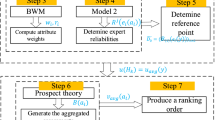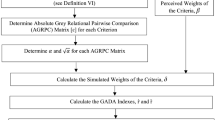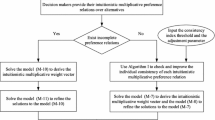Abstract
Group decision making (GDM) is common in real world. Distributed preference relation (DPR) is suitable for capturing the original preference information of decision makers (DMs) in uncertain decision-making environment. The consistency of preference relations is very important to ensure the rationality of decision results. Existing research on the consistency of DPRs assumes that evaluation grades are symmetric on the scale. However, some situations such as risk assessment and investment decisions need to be evaluated with asymmetric and non-uniform evaluation grades. DMs with different cognitive abilities and backgrounds may tend to use multi-granular grade sets, differences in their risk attitudes will lead to different meanings of grades. In this paper, a GDM method with multigranular asymmetric evaluation information is developed. First, a general grade score function is proposed to represent both symmetric and asymmetric grade sets selected by DMs. Due to the limited rationality, it is difficult to ensure that DMs’ subjective preferences are perfectly consistent. Therefore, we establish the consistency of DPRs on a set of asymmetric grades. Considering the willingness of DMs and adjustment magnitude, interactive local adjustment and global adjustment algorithms are presented to achieve acceptable consistency for inconsistent DPR matrices. The different grade sets are unified through conversion between grades, which enables DPRs to be aggregated by evidential reasoning (ER) approach. An example of a decision problem involving investment risk is provided, and the results of comparative analysis demonstrate the validity of the proposed method.
Graphical abstract























Similar content being viewed by others
Explore related subjects
Discover the latest articles, news and stories from top researchers in related subjects.Data availability
The data of the current study are available from the corresponding author on reasonable request.
References
Fu C, Chang WJ, Liu WJ, Yang SL (2022) Consistency of distributed preference relations. J Oper Res Soc 73(4):905–918
Cao MS, Wu J, Chiclana F, Ureña R, Herrera-Viedma E (2020) A personalized consensus feedback mechanism based on maximum harmony degree. IEEE Trans Syst Man Cybern Syst 51(10):6134–6146
Zhou M, Guan ZX, Chen YW, Zhou ZP, Wu J, Herrera-Viedma E (2022) Consistency and consensus reaching process for group decision making based on complete interval distributed preference relations under social network analysis. Inf Fusion 88:126–145
Zhang HJ, Li CC, Liu YT, Dong YC (2019) Modeling personalized individual semantics and consensus in comparative linguistic expression preference relations with self-confidence: An optimization-based approach. IEEE Trans Fuzzy Syst 29(3):627–640
Xiao J, Wang XL, Zhang HJ (2022) Exploring the ordinal classifications of failure modes in the reliability management: An optimization-based consensus model with bounded confidences. Group Decis Negot 31(1):49–80
Chen Z-S, Zhou M-D, Chin K-S, Darko A, Wang X-J, Pedrycz W (2023) Optimized decision support for BIM maturity assessment. Autom Constr 149:104808
Chen ZS, Zhang X, Rodríguez RM, Pedrycz W, Martínez L, Skibniewski MJ (2022) Expertise-structure and risk-appetite-integrated two-tiered collective opinion generation framework for large-scale group decision making. IEEE Trans Fuzzy Syst 30(12):5496–5510
Gai TT, Cao MS, Chiclana F, Zhang Z, Dong YC, Herrera-Viedma E, Wu J (2023) Consensus-trust driven bidirectional feedback mechanism for improving consensus in social network large-group decision making. Group Decis Negot 32(1):45–74
Zhang GQ, Dong YC, Xu YF (2014) Consistency and consensus measures for linguistic preference relations based on distribution assessments. Inf Fusion 17:46–55
Zhang YX, Xu ZS, Wang H, Liao HC (2016) Consistency-based risk assessment with probabilistic linguistic preference relation. Appl Soft Comput 49:817–833
Fu C, Xu DL, Yang SL (2016) Distributed preference relations for multiple attribute decision analysis. J Oper Res Soc 67(3):457–473
Orlovsky S (1978) Decision-making with a fuzzy preference relation. Fuzzy Sets Syst 1(3):155–167
Szmidt E, Kacprzyk J (2003) A consensus-reaching process under intuitionistic fuzzy preference relations. Int J Intell Syst 18(7):837–852
Xia MM, Xu ZS (2013) Managing hesitant information in GDM problems under fuzzy and multiplicative preference relations. Int J Uncertainty Fuzziness Knowl-Based Syst 21(6):865–897
Xu ZS (2001) A practical method for priority of interval number complementary judgment matrix. Oper Res Manag Sci 10(1):16–19
Dong YC, Wu YZ, Zhang HJ, Zhang GQ (2015) Multi-granular unbalanced linguistic distribution assessments with interval symbolic proportions. Knowl-Based Syst 82:139–151
Chen ZS, Chen JY, Chen YH, Yang Y, Jin LS, Herrera-Viedma E, Pedrycz W (2023) Large-group failure mode and effects analysis for risk management of angle grinders in the construction industry. Inf Fusion 97:101803
Chen ZS, Zhu ZZ, Wang ZJ, Tsang YP (2023) Fairness-aware large-scale collective opinion generation paradigm: A case study of evaluating blockchain adoption barriers in medical supply chain. Inf Sci 635:257–278
Li ZL, Zhang Z (2023) Threshold-based value-driven method to support consensus reaching in multicriteria group sorting problems: a minimum adjustment perspective. IEEE Trans Comput Soc Syst 1-14
Yang YL, Gai TT, Cao MS, Zhang Z, Zhang HJ, Wu J (2023) Application of group decision making in shipping industry 4.0: Bibliometric Analysis, Trends, and Future Directions. Systems 11(2):69
Zhou M, Hu M, Chen YW, Cheng BY, Wu J, Herrera-Viedma E (2022) Towards achieving consistent opinion fusion in group decision making with complete distributed preference relations. Knowl-Based Syst 236:107740
Wu YZ, Zhang Z, Kou G, Zhang HJ, Chao XR, Li CC, Dong YC, Herrera F (2021) Distributed linguistic representations in decision making: Taxonomy, key elements and applications, and challenges in data science and explainable artificial intelligence. Inf Fusion 65:165–178
Wang YM, Yang JB, Xu DL (2006) Environmental impact assessment using the evidential reasoning approach. Eur J Oper Res 174(3):1885–1913
Yang JB (2001) Rule and utility based evidential reasoning approach for multiattribute decision analysis under uncertainties. Eur J Oper Res 131(1):31–61
Fu C, Yang JB, Yang SL (2015) A group evidential reasoning approach based on expert reliability. Eur J Oper Res 246(3):886–893
Wang JH, Hao JY (2006) A new version of 2-tuple fuzzy linguistic representation model for computing with words. IEEE Trans Fuzzy Syst 14(3):435–445
Herrera F, Herrera-Viedma E, Martínez L (2008) A fuzzy linguistic methodology to deal with unbalanced linguistic term sets. IEEE Trans Fuzzy Syst 16(2):354–370
Cai M, Gong ZW, Yu XB (2017) A method for unbalanced linguistic term sets and its application in group decision making. Int J Fuzzy Syst 19(3):671–682
Zhang Z, Yu WY, Martínez L, Gao Y (2019) Managing multigranular unbalanced hesitant fuzzy linguistic information in multiattribute large-scale group decision making: A linguistic distribution-based approach. IEEE Trans Fuzzy Syst 28(11):2875–2889
Wu J, Chen J, Liu W, Liu YJ, Liang CY, Cao MS (2022) A calibrated individual semantic based failure mode and effect analysis and its application in industrial internet platform. Mathematics 10(14):2492
Zhou W, Xu ZS (2016) Generalized asymmetric linguistic term set and its application to qualitative decision making involving risk appetites. Eur J Oper Res 254(2):610–621
Lin H (2017) An approach to linguistic multi-attribute decision making based on risk preferences of decision makers. In: 2017 29th Chinese Control And Decision Conference (CCDC). IEEE, pp 7274–7279
Wu XL, Liao HC (2019) A consensus-based probabilistic linguistic gained and lost dominance score method. Eur J Oper Res 272(3):1017–1027
Liao HC, Qin R, Gao CY, Wu XL, Hafezalkotob A, Herrera F (2019) Score-HeDLiSF: A score function of hesitant fuzzy linguistic term set based on hesitant degrees and linguistic scale functions: An application to unbalanced hesitant fuzzy linguistic MULTIMOORA. Inf Fusion 48:39–54
Wang JQ, Wu JT, Wang J, Zhang HY, Chen XH (2014) Interval-valued hesitant fuzzy linguistic sets and their applications in multi-criteria decision-making problems. Inf Sci 288:55–72
Xue M, Fu C, Yang SL (2022) A comparative analysis of probabilistic linguistic preference relations and distributed preference relations for decision making. Fuzzy Optim Decis Making 21(1):71–97
Li CC, Dong YC, Xu YJ, Chiclana F, Herrera-Viedma E, Herrera F (2019) An overview on managing additive consistency of reciprocal preference relations for consistency-driven decision making and fusion: Taxonomy and future directions. Inf Fusion 52:143–156
Dong YC, Li CC, Herrera F (2015) An optimization-based approach to adjusting unbalanced linguistic preference relations to obtain a required consistency level. Inf Sci 292:27–38
Yang Y, Wang XX, Xu ZS (2019) The multiplicative consistency threshold of intuitionistic fuzzy preference relation. Inf Sci 477:349–368
Saaty TL (1994) Fundamentals of decision making and priority theory with the analytic hierarchy process. RWS Publications
Dong YC, Xu YF, Li HY (2008) On consistency measures of linguistic preference relations. Eur J Oper Res 189(2):430–444
Xu YJ, Wen XW, Sun H, Wang HM (2018) Consistency and consensus models with local adjustment strategy for hesitant fuzzy linguistic preference relations. Int J Fuzzy Syst 20(7):2216–2233
Feng XQ, Pang XD, Zhang L (2020) On consistency and priority weights for interval probabilistic linguistic preference relations. Fuzzy Optim Decis Mak 19(4):529–560
Zhang ZM, Pedrycz W (2018) A consistency and consensus-based goal programming method for group decision-making with interval-valued intuitionistic multiplicative preference relations. IEEE Trans Cybern 49(10):3640–3654
Liu YT, Zhang HJ, Wu YZ, Dong YC (2019) Ranking range based approach to MADM under incomplete context and its application in venture investment evaluation. Technol Econ Dev Econ 25(5):877–899
Herrera F, Herrera-Viedma E (2000) Linguistic decision analysis: steps for solving decision problems under linguistic information. Fuzzy Sets Syst 115(1):67–82
Gong ZW, Tan X, Yang YJ (2019) Optimal weighting models based on linear uncertain constraints in intuitionistic fuzzy preference relations. J Oper Res Soc 70(8):1296–1307
Jf C, Xw L, Wang L, Wang YM (2018) A group decision making approach based on newly defined additively consistent interval-valued intuitionistic preference relations. Int J Fuzzy Syst 20(3):1027–1046
Meng FY, Pedrycz W, Tang J (2021) Research on the consistency of additive trapezoidal fuzzy preference relations. Expert Syst Appl 186:115837
Chiclana F, Herrera-Viedma E, Alonso S, Herrera F (2008) Cardinal consistency of reciprocal preference relations: a characterization of multiplicative transitivity. IEEE Trans Fuzzy Syst 17(1):14–23
Herrera-Viedma E, Herrera F, Chiclana F, Luque M (2004) Some issues on consistency of fuzzy preference relations. Eur J Oper Res 154(1):98–109
Wang WQ, Xin XL (2005) Distance measure between intuitionistic fuzzy sets. Pattern Recogn Lett 26(13):2063–2069
Wang H, Zs Xu (2016) Interactive algorithms for improving incomplete linguistic preference relations based on consistency measures. Appl Soft Comput 42:66–79
Gao XY, Xiao FY (2022) A generalized χ 2 divergence for multisource information fusion and its application in fault diagnosis. Int J Intell Syst 37(1):5–29
Zhan TX, Xiao FY (2021) A fast evidential approach for stock forecasting. Int J Intell Syst 36(12):7544–7562
Xu YJ, Li KW, Wang HM (2013) Distance-based consensus models for fuzzy and multiplicative preference relations. Inf Sci 253:56–73
Wu J, Cao MS, Chiclana F, Dong YC, Herrera-Viedma E (2020) An optimal feedback model to prevent manipulation behavior in consensus under social network group decision making. IEEE Trans Fuzzy Syst 29(7):1750–1763
Xing YM, Cao MS, Liu YJ, Zhou M, Wu J (2022) A Choquet integral based interval Type-2 trapezoidal fuzzy multiple attribute group decision making for sustainable supplier selection. Comput Ind Eng 165:107935
Ji FX, Cao QW, Li H, Fujita H, Liang CY, Wu J (2022) An online reviews-driven large-scale group decision making approach for evaluating user satisfaction of sharing accommodation. Expert Syst Appl 213:118875
Wu J, Wang S, Chiclana F, Herrera-Viedma E (2021) Two-fold personalized feedback mechanism for social network consensus by uninorm interval trust propagation. IEEE Trans Cybern 52(10):11081–11092
Cao MS, Liu YJ, Gai TT, Zhou M, Fujita H, Wu J (2022) A comprehensive star rating approach for cruise ships based on interactive group decision making with personalized individual semantics. J Mar Sci Eng 10(5):638
Acknowledgements
This research is supported by the National Natural Science Foundation of China under the Grant No.72071056, 71971135 and 72101077, the grant (No. PID2019-103880RB-I00) from the Spanish State Research Agency, and the grant (No. P2000673) from the Andalusian Government.
Author information
Authors and Affiliations
Corresponding author
Ethics declarations
Conflict of interest
The authors certify that there is no conflict of interest with any individual or organization for this paper.
Additional information
Publisher's Note
Springer Nature remains neutral with regard to jurisdictional claims in published maps and institutional affiliations.
Appendix
Appendix
1.1 Proof of Theorem 1
Proof
To show that \(s\left({H}_{n}\right)\in [-\mathrm{1,1}]\) for all \(n\) in \(\{a, \dots ,b\}\), we need to establish the bounds of the function.
-
1.
Lower bound:
First, we need to prove that \(s\left({H}_{n}\right)\ge -1\) for all \(n\) in \(\{a, \dots ,b\}\). From Eq. (7), we have \(s\left({H}_{n}\right)=\mu n+\tau \mathrm{sin}\omega n\). The partial derivative of \(s\left({H}_{n}\right)\) with respect to \(n\) is calculated by
Since \(\mu +\omega \tau \mathrm{cos}\omega n\ge 0\), then \(s\left({H}_{n}\right)\) is monotonically increasing with respect to the variable \(n\). The minimum value of \(s\left({H}_{n}\right)\) occurs when \(n=a\), i.e.
Given \(s\left({H}_{a}\right)\in [-\mathrm{1,1}]\), it is clear that
-
2.
Upper bound:
Next, we need to prove that \(s\left({H}_{n}\right)\le 1\) for all \(n\) in \(\{a, \dots ,b\}\). Since \(\mu +\omega \tau \mathrm{cos}\omega n\ge 0\), the maximum value of \(s\left({H}_{n}\right)\) occurs when \(n=b\), i.e.
Given \(s\left({H}_{b}\right)\in [-\mathrm{1,1}]\), it is clear that
From the lower and upper bounds proofs, we have shown that \(s\left({H}_{n}\right)\) is bounded between -1 and 1 for all \(n\in \{a, \dots ,b\}\). Therefore, we conclude that \(s\left({H}_{n}\right)\in [-\mathrm{1,1}]\) based on Definition 7.
1.2 Proof of Proposition 2
Proof
From Eqs. (17) and (18), we can easily deduce the following results:
For property (1) in Property 2.
If \({r}_{ik}(\mathrm{or} {r}_{kj})=(\mathrm{0,0})\), then
For property (2) in Property 2.
If \({\alpha }_{ik}+{\beta }_{ik}>(\ge )0\) and \({\alpha }_{kj}+{\beta }_{kj}\ge (>)0\), then
Since \({\alpha }_{ik}+\left(1-{\alpha }_{ik}\right){\alpha }_{kj}\ge {\alpha }_{ik}\) and \({\alpha }_{ik}\left(1-{\alpha }_{kj}\right)+{\alpha }_{kj}\ge {\alpha }_{kj}\), then \(max\left\{{\alpha }_{ik},{\alpha }_{kj}\right\}\le {\alpha }_{ij}\le s\left({H}_{{N}_{2}}\right)\).
Hence, \({\alpha }_{ij}+{\beta }_{ij}\ge max\left\{{\alpha }_{ik}+{\beta }_{ik},{\alpha }_{kj}+{\beta }_{kj}\right\}\). Property (3) can be similarly verified.
For properties (4) and (5) in Property 2.
If \({\alpha }_{ik}=s\left({H}_{{N}_{2}}\right)\left({\alpha }_{kj}=s\left({H}_{{N}_{2}}\right)\right)\) and \({\alpha }_{kj}+{\beta }_{kj}\ge 0({\alpha }_{ik}+{\beta }_{ik}\ge 0)\), then
If \({\beta }_{ik}=s({H}_{-{N}_{1}})({\beta }_{kj}=s({H}_{-{N}_{1}}))\) and \({\alpha }_{kj}+{\beta }_{kj}\le 0({\alpha }_{ik}+{\beta }_{ik}\le 0)\), then
For properties (6) and (7) in Property 2.
To show that the function \(\widehat{f}(\overline{f })\) is monotonically increasing with respect to \({\alpha }_{ik}\) and \({\alpha }_{kj}\)(\({\beta }_{ik}\) and \({\beta }_{kj}\)), we need to demonstrate that for any given values of \({\alpha }_{ik}\) and \({\alpha }_{kj}\)(\({\beta }_{ik}\) and \({\beta }_{kj}\)), if we increase these values, the resulting value of \(\widehat{f}\left({\alpha }_{ik},{\alpha }_{kj}\right)\left(\left.\overline{f }\left({\beta }_{ik},{\beta }_{kj}\right)\right)\right.\) also increases.
To prove this, we will consider different cases based on the given definition of \(\widehat{f}\left({\alpha }_{ik},{\alpha }_{kj}\right)\):
-
Case 1: \({\alpha }_{ik}+{\beta }_{ik}>\left(\ge \right)0\) and \({\alpha }_{kj}+{\beta }_{kj}\ge \left(>\right)0\)
When \({\alpha }_{kj}>{\alpha }_{kj}^{\prime}\left({\alpha }_{ik}>{\alpha }_{ik}^{\prime}\right)\) and \({0<\alpha }_{ik}\left({\alpha }_{kj}\right)<s\left({H}_{{N}_{2}}\right)\), then \({\alpha }_{ij}=\widehat{f}\left({\alpha }_{ik},{\alpha }_{kj}\right)=min\{{\alpha }_{ik}+{\alpha }_{kj}-{\alpha }_{ik}{\alpha }_{kj},{s(H}_{{N}_{2}})\}={\alpha }_{ik}+{\alpha }_{kj}-{\alpha }_{ik}{\alpha }_{kj}\).
If \({\alpha }_{kj}>{\alpha }_{kj}^{\prime}\) and \({0<\alpha }_{ik}<s\left({H}_{{N}_{2}}\right)\)
The same conclusion can be similarly drawn when \({\alpha }_{ik}>{\alpha }_{ik}^{\prime}\) and \(0<{\alpha }_{kj}<s\left({H}_{{N}_{2}}\right)\).
-
Case 2: \({\alpha }_{ik}+{\beta }_{ik}<\left(\le \right)0\) and \({\alpha }_{kj}+{\beta }_{kj}\le \left(<\right)0\)
If \({\alpha }_{kj}>{\alpha }_{kj}^{\prime}\) and \({0<\alpha }_{ik}<s\left({H}_{{N}_{2}}\right)\)
Similarly, it can be concluded that \({\alpha }_{ij}>{\alpha }_{ij}^{\prime}\) when \({\alpha }_{ik}>{\alpha }_{ik}^{\prime}\) and \(0<{\alpha }_{kj}<s\left({H}_{{N}_{2}}\right)\).
-
Case 3: \(\left({\alpha }_{ik},{\beta }_{ik}\right)\) or \(({\alpha }_{kj},{\beta }_{kj})=\left(\mathrm{0,0}\right)\)
If \({\alpha }_{kj}>{\alpha }_{kj}^{\prime}\) and \({0<\alpha }_{ik}<s\left({H}_{{N}_{2}}\right)\)
If \({\alpha }_{ik}>{\alpha }_{ik}^{\prime}\) and \(0<{\alpha }_{kj}<s\left({H}_{{N}_{2}}\right)\), \({\alpha }_{ij}-{\alpha }_{ij}^{\prime}={\alpha }_{ik}-{\alpha }_{ik}^{\prime}>0\).
-
Case 4: \(({\alpha }_{ik}+{\beta }_{ik})({\alpha }_{kj}+{\beta }_{kj})<0\) or other situations.
If \({\alpha }_{kj}>{\alpha }_{kj}^{\prime}\) and\({0<\alpha }_{ik}<s\left({H}_{{N}_{2}}\right)\) ,
For properties (6) and (7) in PropertyGiven \({\alpha }_{ik}\), the partial derivative of \(\widehat{f}\) with respect to \({\alpha }_{kj}\) is calculated by
Thus, we can deduce that \({\alpha }_{ij}>{\alpha }_{ij}^{\prime}\). Similarly, \({\alpha }_{ij}>{\alpha }_{ij}^{\prime}\) holds when \({\alpha }_{ik}>{\alpha }_{ik}^{\prime}\) and \(0<{\alpha }_{kj}<s\left({H}_{{N}_{2}}\right)\).
-
Case 5: \({\alpha }_{ik}=-{\beta }_{kj}\) and \({\beta }_{ik}=-{\alpha }_{kj}\)
When \({\alpha }_{kj}>{\alpha }_{kj}^{\prime}\) and \({0<\alpha }_{ik}<s\left({H}_{{N}_{2}}\right)\), as \({\alpha }_{ij}+{\beta }_{ij}=0\), if \({\alpha }_{ik}+ {\beta }_{ik}\le 0\), then \({\alpha }_{kj}^{\prime}+{\beta }_{ik}<0\), \({\alpha }_{ij}-{\alpha }_{ij}^{\prime}=\widehat{f}\left({\alpha }_{ik},{\alpha }_{kj}\right)-\widehat{f}\left({\alpha }_{ik},{\alpha }_{kj}^{\prime}\right)={\alpha }_{ik}\left({\alpha }_{kj}-{\alpha }_{kj}^{\prime}\right)>0\).
If \({\alpha }_{ik}+ {\beta }_{ik}>0\) and \({\alpha }_{kj}^{\prime}+{\beta }_{ik}=0\),
If \({\alpha }_{ik}+ {\beta }_{ik}>0\) and \({\alpha }_{kj}^{\prime}+{\beta }_{ik}<0\),
From case 4, it is clear that \({\alpha }_{ij}>{\alpha }_{ij}^{\prime}\). The same conclusion can be similarly drawn when \({\alpha }_{ik}>{\alpha }_{ik}^{\prime}\) and \(0<{\alpha }_{kj}<s\left({H}_{{N}_{2}}\right)\).
In all the cases considered, we have shown that \(\widehat{f}\left({\alpha }_{ik},{\alpha }_{kj}\right)\) is monotonically increasing with respect to \({\alpha }_{ik}\). As swapping \({\alpha }_{ik}\) and \({\alpha }_{kj}\) does not change the value of \(\widehat{f}\left({\alpha }_{ik},{\alpha }_{kj}\right)\), the function \(\widehat{f}\) is symmetric. Therefore, \(\widehat{f}\left({\alpha }_{ik},{\alpha }_{kj}\right)\) is monotonically increasing with respect to \({\alpha }_{kj}\). The function \(\overline{f }\) is monotonically increasing with respect to \({\beta }_{ik}\) and \({\beta }_{kj}\) can be proved similarly.
For property (8) in Property 2.
If \({\alpha }_{ik}+{\beta }_{ik}={\alpha }_{kj}+{\beta }_{kj}=0\), then
Because \(\widehat{f}\) and \(\overline{f }\) are monotonically increasing, then \({\alpha }_{ij}+{\beta }_{ij}=0\), \(min\{{\alpha }_{ik},{\alpha }_{kj}\}\le {\alpha }_{ij}\le 0.5\) and \(-0.5\le {\beta }_{ij}\le max\{{\beta }_{ik}, {\beta }_{kj}\}\).
For property (9) in Property 2.
If \({\alpha }_{ik}=-{\beta }_{kj}\) and \({\beta }_{ik}=-{\alpha }_{kj}\), then \({\alpha }_{ik}+{\beta }_{ik}=-({\alpha }_{kj}+{\beta }_{kj})\). If \({\alpha }_{ik}+{\beta }_{ik}=0\), \({\alpha }_{kj}+{\beta }_{kj}=0\); if \({\alpha }_{ik}+{\beta }_{ik}>0\), \({\alpha }_{kj}+{\beta }_{kj}<0\); if \({\alpha }_{ik}+{\beta }_{ik}<0\), \({\alpha }_{kj}+{\beta }_{kj}>0\). Then, we have
For property (10) in Property 2.
If \(\left({\alpha }_{ik}+{\beta }_{ik}\right)\left({\alpha }_{kj}+{\beta }_{kj}\right)<0\) and \(\left({\alpha }_{ik}+{\beta }_{ik}\right)+\left({\alpha }_{kj}+{\beta }_{kj}\right)>0\), we have \(\left|{\alpha }_{ik}\right|+\left|{\alpha }_{kj}\right|>\left|{\beta }_{ik}\right|+\left|{\beta }_{kj}\right|\). Since \(\widehat{f}\) and \(\overline{f }\) are monotonically increasing, then
Similarly, property (11) in Property 2 is proved.
Rights and permissions
Springer Nature or its licensor (e.g. a society or other partner) holds exclusive rights to this article under a publishing agreement with the author(s) or other rightsholder(s); author self-archiving of the accepted manuscript version of this article is solely governed by the terms of such publishing agreement and applicable law.
About this article
Cite this article
Zhou, M., Li, XH., Cheng, BY. et al. Group decision making based on consistency adjustment of distributed preference relations under asymmetric evaluation grades. Appl Intell 54, 1144–1178 (2024). https://doi.org/10.1007/s10489-023-05119-w
Accepted:
Published:
Issue Date:
DOI: https://doi.org/10.1007/s10489-023-05119-w




